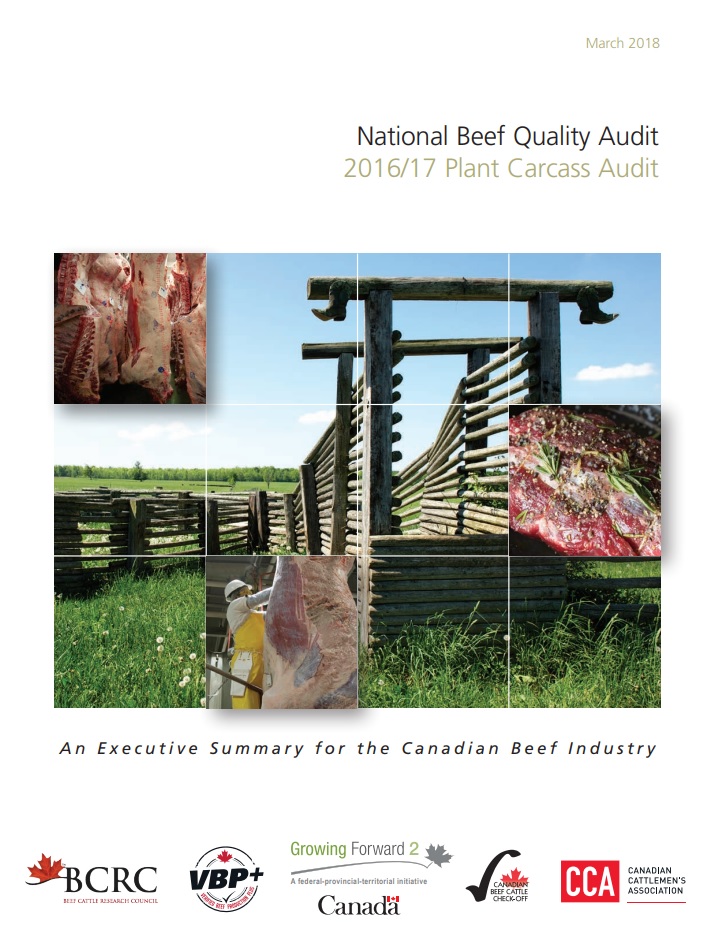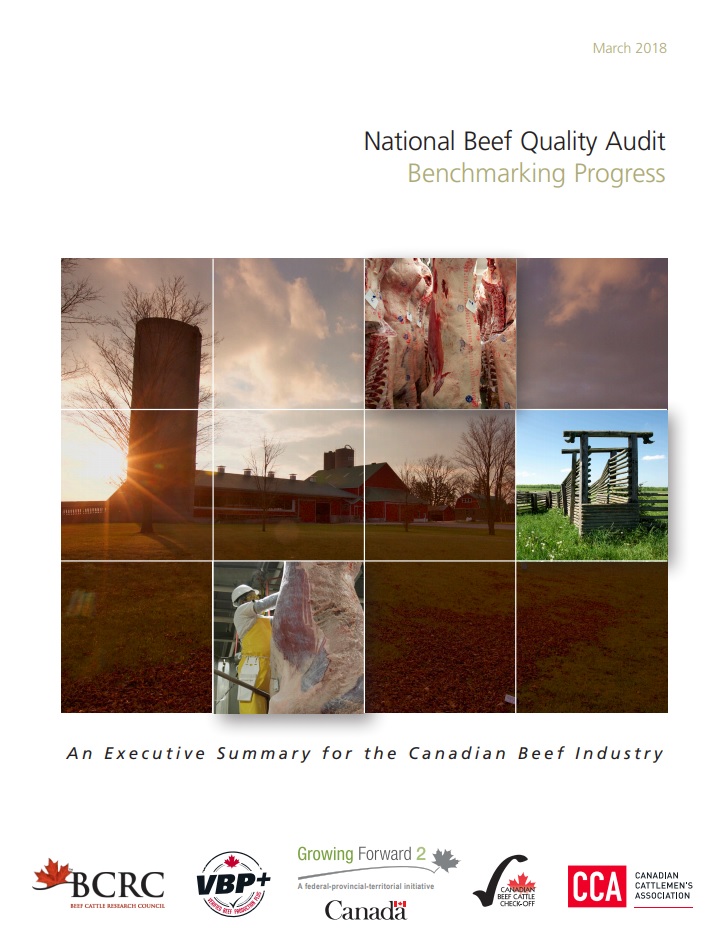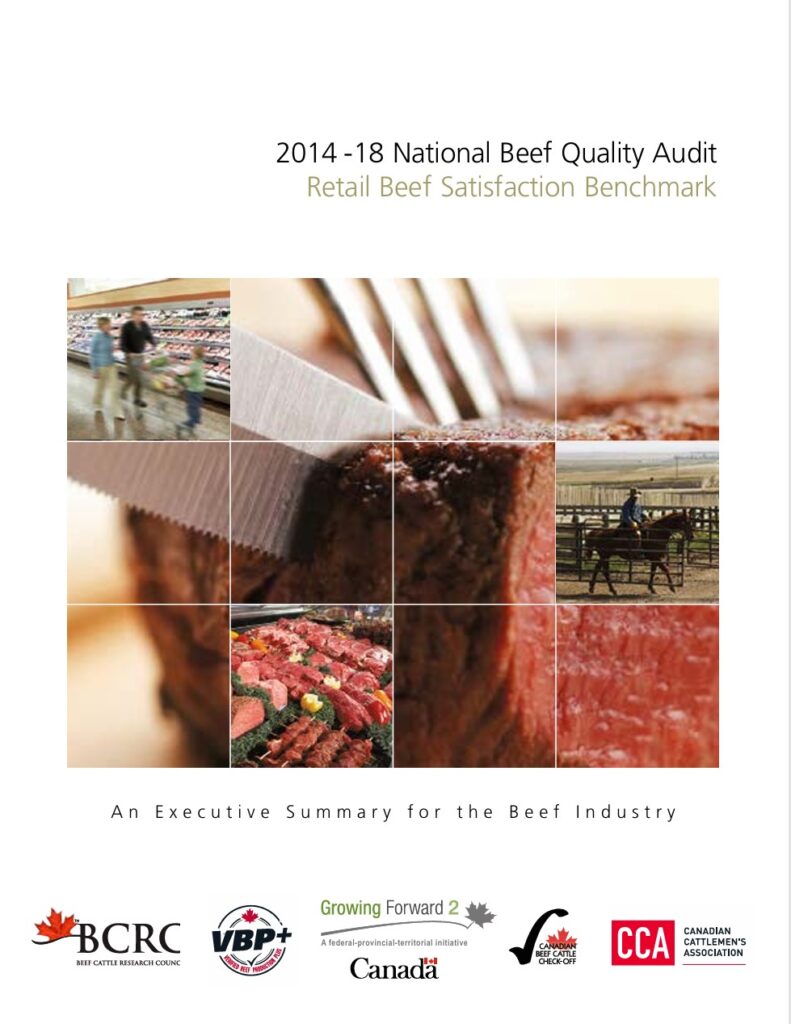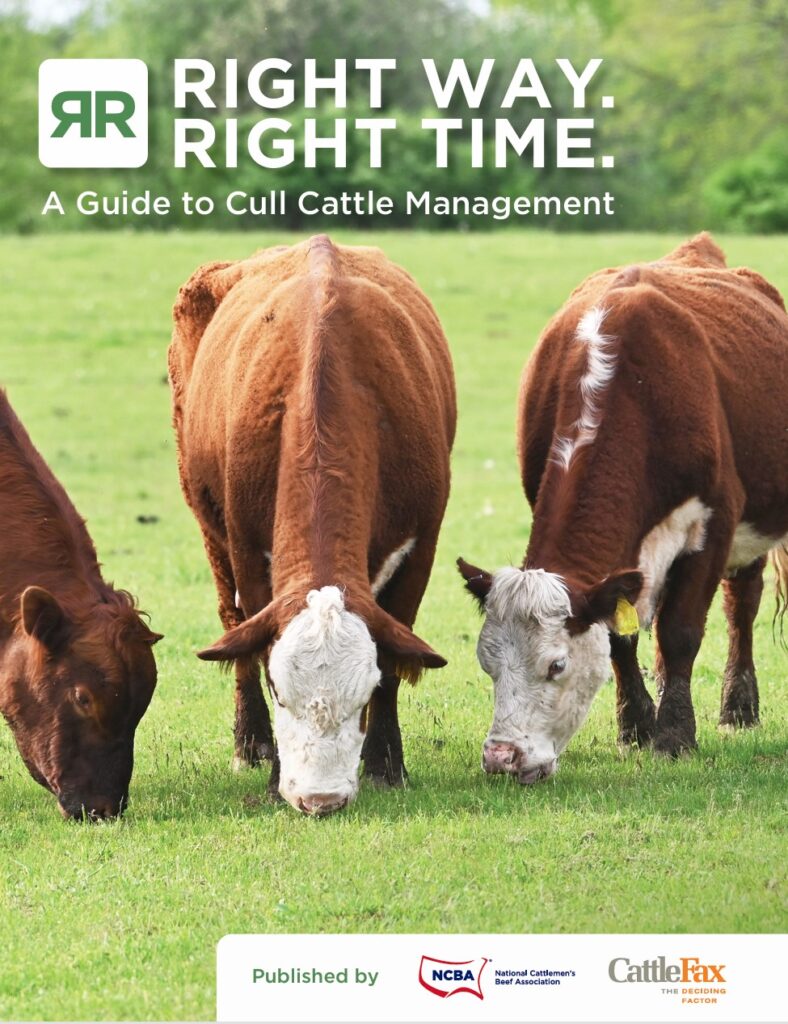Consumer satisfaction is critically important to the Canadian beef industry. Regular audits provide the information necessary to enhance the quality and safety of Canadian beef while increasing the profitability of the Canadian beef and cattle industry. An audit helps the industry to:
- identify ways in which Canadian beef may be superior to its international competitors
- identify carcass and beef quality attributes that could be improved through animal and carcass management, and
- measure improvements in quality of Canadian beef over time.
| Key Points |
|---|
| The National Beef Quality Audit aims to improve the value of the carcass by delivering a consistent high quality beef product to consumers and the results are used to develop strategies to reduce the incidence of defects, including communications with cattle producers through the Verified Beef Production TM Plus (VBP+) program |
| To minimize liver abscesses, feedlot operators should work with a generalized nutritionist to develop good feed management and ration change practices that prevent grain overload. |
| Production practices including choosing non-slip flooring in cattle handling areas, ensure smooth surfaces on handling equipment, dehorning at an early age and low stress handling decrease carcass bruising |
| Producers can prevent economic losses due to horns by using polled bulls in breeding programs or dehorning cattle early in age using proper procedures |
| Hide damage due to branding can be prevented or decreased by minimizing or avoiding branding cattle (except where required by law), using alternative forms of identification and altering branding practices including brand location, size of the brand and branding method |
| Consumer satisfaction with beef eating quality depends on the tenderness, juiciness and flavour, with satisfaction remaining high for Canadian beef steaks |
| Beef tenderness can be improved through farm practices including genetic selection favouring tenderness, reducing injection site lesions, and selection of young animals for slaughter |
National Beef Quality Audit
The National Beef Quality Audit (NBQA) was first undertaken in 1995 with the intent to measure quality defects which could be managed primarily through the efforts of cattle producers. The initial audit provided a benchmark against which future audits were measured. Subsequent audits were conducted in 1999, 2010/11 and 2017/18. The ultimate goal is to improve the value of the carcass by delivering a consistent high quality beef product to consumers domestically and around the world.
All audits involve the collection of carcass data in packing plants in eastern and western Canada and include all classes of cattle. In addition to identifying the severity of defects, the economic impact or the cost to the industry is estimated.
The quality audit is conducted at two levels, processor and consumer. The process audit is done on the slaughter floor as well as in the cooler. Quality defects or nonconformities associated with steers, heifers cows and bulls are identified. Consumer surveys are used to measure consumer satisfaction with the juiciness, flavour and tenderness of beef steaks. Meat research is also done to assess various characteristics.
Beef Quality Defects
Beef quality defects cause economic losses due to reductions in usable meat on the carcass and added labour to remove defects from the carcass. By assigning economic values to the various defects, those with the greatest economic impact can be identified. Some animal management practices are known causes for beef quality defects.
The results of the NBQA are used to develop strategies to reduce the incidence of defects, including communications with cattle producers through the Verified Beef ProductionTM Plus (VBP+) program. With knowledge of the incidence, severity and causes of carcass defects, producers can adjust management practices in an effort to minimize price discounts and maximize producer returns.
Liver Defects
The economic loss from liver discounts in 2016 is estimated at $20.98/head for all cattle, with a total industry loss of $61.2 million. This compares to an industry loss of $9.36/head for all cattle in 2011 or $29.9 million and $8.8 million in 1999.
Livers are assessed and discounted based on their classification (suitable for human consumption, pet food, or condemned) based on severity of liver abscesses. Liver abscesses are influenced by multiple factors, many of which are not clearly understood.
To minimize liver abscesses, feedlot operators should work with a nutritionist to develop good feed management and ration change practices that prevent grain overload. Take particular care when balancing rations that include feeds most likely to cause grain overload, such as wheat.
Research is currently underway to better understand and prevent liver defects.
Bruising
The economic loss to the industry in 2016 due to bruises on the carcasses was estimated at $1.90/head or $5.55 million compared to $2.10/head or $6.7 million in 2011.
Bruises are caused by many factors and range in severity. Bruising has the potential to result in critical amounts of trim (over 3.2 lbs) to carcasses, including primal cuts, however, most bruising results in minimal trim.
In the 2016/17 audit, 32.6% of fed cattle and 63% of non-fed had bruises, compared to 34% and 85.7%, respectively in the 2010/11 audit.
To prevent or minimize bruising:
- Use non-slip flooring in all cattle handling areas and transport trailers to prevent falls
- Ensure smooth surfaces on all handling equipment such as gates, fences and chutes
- Dehorn surrounding animals early in age using proper procedures
- Handle cattle calmly and quietly. Temperament is heritable, so cull wild cows and their daughters.
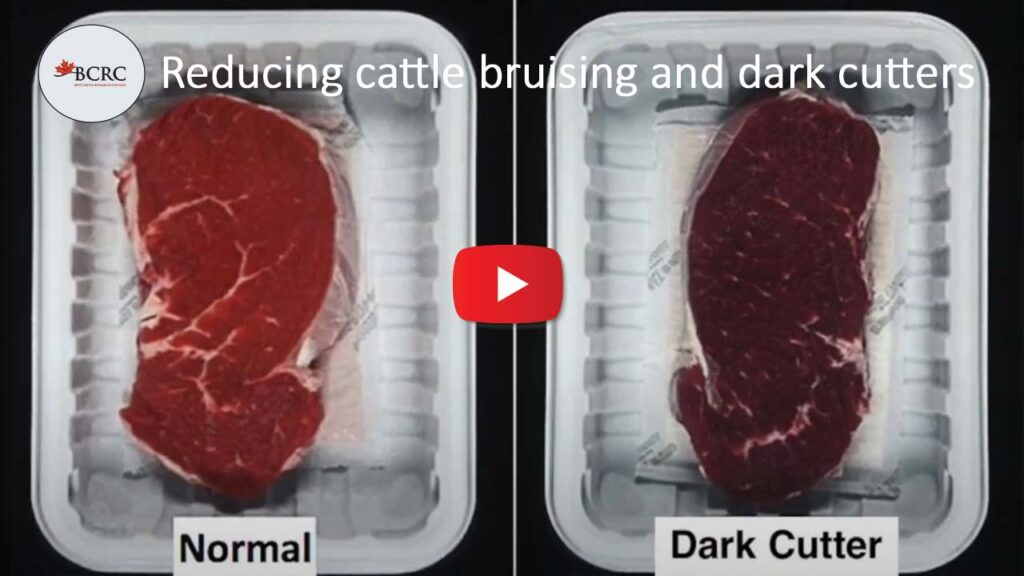
Dark Cutting Beef
Carcasses that ‘cut dark’ are assigned a grade of Canada B4. Darking cutting beef is dark red in colour, and due to its high pH, has a reduced shelf-life and increased toughness compared to typical beef.
Dark cutters (B4) at 1.64% of youthful cattle in 2016 was up from 1.28% in 2010/11 and 0.84% in 1998/99. Regionally dark cutters have varied widely over the last seven years from a low of 1.04% in 2010 to a high of 2.13% in 2014 in the west. The variance in the east has been slightly narrower from a low of 1.09% in 2012 to a high of 1.63% in 2017.
Horns
Processors lost $176,086 in 2016 ($0.06/head) versus $192,535 in 2011 ($0.06/head) and $106,003 ($0.032/head) in 1999 due to extra labour costs for knocking off the horns.
Horns cause economic losses from bruising, head condemnations, and extra labor in the packing plant.
To prevent economic losses due to horns, producers can:
- Use polled bulls in breeding programs
- Dehorn cattle early in age using proper procedures
Tag
Tag cost the beef industry $10.21/head on average or $29.8 million in 2016 versus $26 million in 2011 and $30.6 million in 1999. These costs are a result of hide damage, trim losses and increased labour costs at the packing plant.
Tag is the manure and mud on the hide of an animal, and it is a problem particularly when feedlot conditions are wet. Any visual contamination on the carcass following the removal of the hide must be trimmed. Therefore, tag can result in increased labour costs to the packer and losses to producers due to reductions in meat yield. Tag also lowers the quality and the value of the hide.
To prevent or minimize tag when cattle are sold for slaughter:
- Keep pens, alleys, loading and unloading areas clean and dry
- Keep transport trucks clean and dry
- Clean pens frequently and provide adequate bedding, such as wood chips or straw
- Design pens and working areas to ensure good drainage
Branding
The economic loss to the industry because of hide damage due to branding for all cattle was $1.07/head or $3.1 million in 2016 compared to $0.88/head or total $2.8 million in 2011 and $15.8 million in 1999.
Brands cause economic loss due to hide damage. Overall, the number of branded hides has decreased significantly since 1999. Since the 2010/11 audit, fed cattle brands are up 9%, while non-fed brands are down 23%.
To prevent or minimize hide damage due to branding:
- Avoid branding or rebranding cattle, except where required by law
- Use alternative forms of identification, such as an ear tag or tattoo
- Locate brands on the hip or shoulder to reduce the extent of the damage
- Use smaller brands
- Consider freeze branding
Injection Site Lesions
Injection site lesions cost the industry $0.56/head or $1.63 million in 2016 compared to $0.21/hd or $662,951 in 2011 due to higher prevalence rates.
Injection site lesions cause localized toughness. They are more common in non-fed cattle. The majority of fed cattle are healthy, finished animals from feedlots and have not been recently treated with any vaccine or drug.
The occurrence of surface injection site lesions has increased significantly in both fed and non-fed cattle from 0.56% and 7.34% in the 2010/11 audit to 4.45% and 13.69% respectively in the 2016/17 audit.
To minimize the cost of injection site lesions, producers should:
- Use subcutaneous injections when possible
- Avoid use of dart guns
- Avoid needles in the hindquarters
- Replace dull or bent needles
Body Condition Scores
Body condition score (BCS) is a subjective measure to assess the amount of body fat on an animal following the removal of the hide. (1 = very thin; 5= grossly fat). Market cows in low BCS are more susceptible to injury and bruising in transit.
To ensure good BCS, work with a qualified nutritionist to develop a feeding program that will help ensure optimal BCS at various times of the year for the cow herd. Learn more at www.bodyconditionscoring.ca.
Implants
Implants generally increase average daily gain and improve feed efficiency but decrease quality grade.
Beta-Agonists
All beta-agonists approved for beef cattle increase protein deposition (muscle growth), growth rate, feed efficiency, and carcass leanness. Some beta-agonists also reduce protein turnover (reduce muscle breakdown), resulting in increased dressing percentage.
Characteristics of Beef Quality/Consumer Satisfaction
Consumer satisfaction with beef eating quality primarily depends on the
- tenderness
- juiciness, and
- flavour
of beef products.
The 1995 consumer survey found that tenderness was the number one concern for consumers, followed by juiciness and flavour. This was confirmed again in 2015. Each of these three attributes can be enhanced through good production practices at the farm, as well as at the meat processing facility.
Audits in 2001 and 2009 showed an improved consumer rating for tenderness, juiciness and flavour and overall consumer satisfaction. This improvement could be a result of improved production practices as well as the use of interventions such as mechanical tenderization. Consumer ratings for overall satisfaction with study steaks remained essentially unchanged in 2015.
Historically consumer satisfaction has been driven by tenderness although with continued improvement, juiciness and flavour have become more important. Tenderness in retail beef has improved slightly since 2009 following a significant improvement in the decade prior.
The 2015 Retail Beef Satisfaction study revealed that 86% of consumers give an overall score of 7/10 or higher on satisfaction of Canadian beef steaks, with 24% of consumers giving a perfect rating of 10/10. Around 12% of consumers blame their own cooking methods when steaks are not perfect.
The price per unit increased by 39% in 2015 compared to 2009. The average thickness and the weight of steaks was slightly lower in 2015. A long-term trend towards increasing carcass weights (an average increase of 7 pounds per year since 1975) requires that steaks be cut thinner to maintain a consistent weight.
Tenderness
Tenderness has commonly been identified as the most important contributor to palatability. Research shows that consumers are willing to pay more for guaranteed tender beef. Therefore, reducing inconsistency and the proportion of carcasses with tougher beef is a top priority for the Canadian beef industry. All sectors of the industry have a role to play in improving tenderness.
Improving Tenderness on the Farm
Tenderness has a strong genetic component. Reliable DNA markers are commercially available in seedstock selection decisions.
Proper animal health practices will minimize the risk of injection site lesions that result in localized toughness.
Selection of young cattle for beef production enhances tenderness. Typically, both the amount of connective tissue (collagen) and the resistance of collagen to breakdown during cooking increases as animals become older.
Properly matching the growth promotants (implants and feed additives) used to the cattle being fed can help to minimize some avoidable toughness issues.
Improving Tenderness at the Processor
Truckers and processing facilities can help ensure tenderness by handling animals carefully to minimize stress during transport and before stunning.
Tenderness can also be improved by electrical stimulation of the beef carcass and controlled carcass chilling. Appropriate aging of certain beef cuts in temperature-controlled environments enhances tenderness through the actions of natural enzymes which soften muscle fibers.
Carcass Grading
Visit the Carcass Grading page to learn more.
Cull Cattle Management
Cull cattle are typically associated with ground beef production however, some market cows and bulls have the potential to yield prime cuts to be sold to retailers. With planning, cull animals can be a source of revenue to producers and effective management to increase beef quality of these animals will result in further gains.
Webinar
Videos
2017-18 NBQA Results Videos Playlist
2010-11 NBQA Results Videos Playlist
Feedback
Feedback and questions on the content of this page are welcome. Please e-mail us at [email protected].
This content was last reviewed November 2024.
